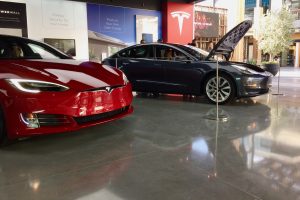Ford is planning for a major restructuring of its electric vehicle offensive with a massive budget of up to $20 billion. Bloomberg reports that Ford will utilize specific strategies that Tesla used to gain its notoriety as the EV leader, including a road map for vehicle launches and manufacturing planning and a sizeable budget.
Ford has made drastic changes to its EV leadership, including the acquisition of Doug Field, a former Tesla engineer who left the company for Apple and then left Apple for Ford in 2021. Overall, the total electrification reorganization plan has a budget of between $10 and $20 billion, giving Ford free range in terms of what its capabilities will be moving forward.
One of the most crucial portions of Ford’s new plan is to transition factories that are responsible for manufacturing gas-powered vehicles into EV plants. A sizeable portion of the investment will be set aside for this task and could take up to ten years to complete, sources familiar with the matter told the publication.
“We are executing our Ford Plus plan to transform the company and thrive in this new era of electric and connected vehicles. We would not comment on speculation,” Ford’s Communications Chief, Mark Truby, said.
Recently, Ford committed to a lofty goal of 600,000 deliveries within 22 months. CEO Jim Farley believes Ford can be “one of the first to scale” in terms of legacy car companies. Ford has largely been the most committed legacy company to adopt EVs, launching several highly competitive vehicles in its first few years. F-150 Lightning deliveries are expected to begin in the Spring, and the Mustang Mach-E was the second-best-selling crossover SUV EV in 2021, trailing only the Tesla Model Y.
Spearheaded by Farley, who recently commented that Ford would not abandon its Rivian investment, the playbook is relatively similar to the one EV leader Tesla used to launch its company from an unlikely success story to the most valuable automaker globally. The Elon Musk-led company used a product roadmap in its early days, primarily described in its Master Plan, to funnel its early projects into essentially fundraising campaigns for cheaper, mass-market vehicles in the future. It is unknown if Ford will use this strategy exactly, but the main goal is to transition its existing plants into EV production sites. Ford reached a market cap of $100 billion. The company’s valuation has increased 269 percent since Farley took office.
This is a task that will avoid turning the manufacturing facilities today into the stranded assets of tomorrow. Updating the factories will save Ford time, money, and workforce, as many of its employees will likely be trained to handle electric powertrains. Volkswagen made the same steps at some of its facilities in the past few years and provided on-site training for employees who decided to remain at its factories.
The additional $10 to $20 billion investment will supplement the already $30 billion investment that Farley detailed for Ford earlier. This investment will help Ford accelerate its EV commitment through 2024 and will quadruple initial production guidelines for the F-150 Lightning and triple Mustang Mach-E manufacturing efforts.





